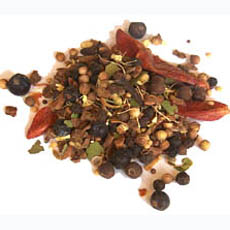TIP OF THE DAY: Slow Cooker Short Ribs
|
We love short ribs, but they do take a long time to cook and tenderize. If you have a pressure cooker, you can do it in 45 minutes (here’s a recipe). If not, a slow cooker does just as nicely.
With this recipe from McCormick, prep time is 30 minutes, slow cooker time is 8 hours. This short ribs recipe is “Asian fusion.” The inspiration is Sauerbraten (sour beef), the German classic that marinates the beef in a mixture of vinegar or wine (the “sour”), spices and seasonings. Here, the Asian twist comes from the use of rice vinegar, soy sauce and bok choy. Consider this dish for Super Bowl Sunday or Valentine’s Day. For Valentine’s Day, garnish the dish with some pomegranate arils. RECIPE: ASIAN-STYLE SLOW COOKER SHORT RIBS Ingredients For 8 Servings |

It’s easy to make short ribs in a slow cooker. Photo courtesy McCormick. |
|
|
1. PLACE the pickling spice in the center of a piece of cheesecloth or a coffee filter. Tie tightly with a long piece of string. Set aside. Coat the short ribs with flour. 2. HEAT the oil in a large, deep skillet or Dutch oven over medium-high heat. Add 1/2 of the short ribs; cook 5 to 10 minutes or until browned on all sides. Add the short ribs to slow cooker. Repeat with the remaining short ribs. 3. PLACE the vegetables and the spice bundle over the short ribs. Mix the beef stock, soy sauce, vinegar and ginger. Pour over the top. 4. COVER and cook for 8 hours on LOW or 4 hours on HIGH, or until the short ribs are tender. Stir in the crushed gingersnaps during last 30 minutes of cooking. Stir in the bok choy during the last 15 minutes of cooking. Discard the spice bundle. Serve the short ribs and vegetables over cooked Asian noodles. |
||
 Pickling spices. Buy them or blend your own using the recipe below. Photo courtesy McCormick. |
WHAT ARE ASIAN NOODLES?
Ribbon pasta—long cut pasta—originated in Asia. This is the type of pasta “discovered” by Marco Polo and brought back to Venice. Because communications were not so great in those days, he didn’t know that Arab traders had brought pasta back with them centuries before, and introduced it to Southern Italy when they invaded in the 8th century. Pasta was a convenience food for travelers: One only needed to boil water to turn the dried pasta in one’s pocket into a nutritious meal. An even earlier Italian pasta was an Etrusco-Roman noodle made from durum wheat called lagane, the descendant of the modern word lasagna, which was mentioned way back in the first century C.E. It was not boiled, as it is today, but baked in an oven. But back to Asia, the motherland of pasta: |
|
|
There are numerous types of Asian noodles based on ingredients alone: arrowroot starch, bean curd skin, bean starch (cellophane noodles), buckhwheat (soba), mung bean threads, rice noodles, sweet potato starch, tofu and yes, wheat noodles (udon). Asian noodles are also made in a broad variety of shapes and sizes. The type of noodle used depends on country and purpose. Some Chinese noodles contain eggs, e.g. Chinese egg noodles, although the majority of Asian noodles do not. Unlike Italian noodles and other Western pasta, Asian noodles are generally not eaten with a sauce on top, but are stir-fried or used in soups and salads. Picking spices are a blend of different spices, ground or whole. They are added to vinegar for making cucumber pickles and other pickled foods. You can purchase them ready-blended, or make your own from this easy combination: 1. COMBINE the ingredients; measure and use as needed. 2. KEEP the unused blend in an airtight container, away from light and heat.
|
||


